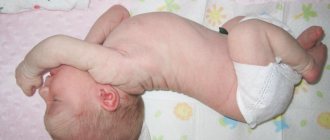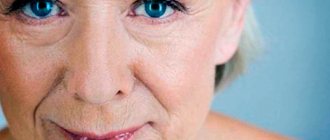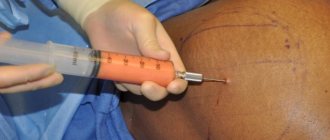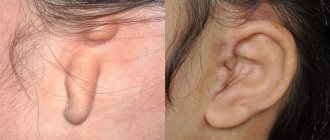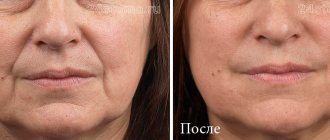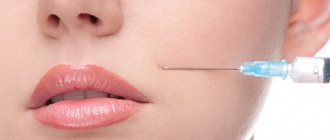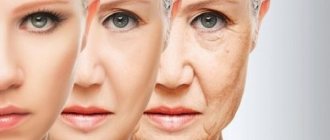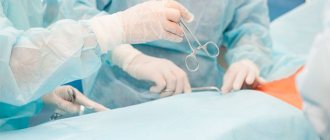Why does a fold appear under the buttocks?
An interesting fact about this problem is that this unpleasant fold (or even two or three) can appear not only in overweight young ladies, but also in fairly slender people. It is found only in female or children's body structure. Often there are signs of asymmetry, and it appears only on one side.
This problem usually appears when the muscles in the buttocks or back begin to weaken. Also, a fold under the buttocks can appear even in trained individuals. If a woman has been involved in sports for a long time, and for some reason there is a long break, the muscles in this area sag and weaken.
Treatment methods
If one buttock is larger than the other in a child , then the following methods of conservative treatment are used:
- use of orthopedic aids - corsets, orthoses, insoles, special shoes, stirrups;
- manual therapy;
- physical therapy;
- massage;
- physiotherapy.
Back treatment
Facial rejuvenation
Figure correction
Pediatrics
Buttock asymmetry is a serious aesthetic problem that causes one of the patient's buttocks to appear larger than the other. This pathology has an extremely negative effect on appearance and spoils the figure. Do you dream of getting rid of torsion and distortion of the pelvis? At Dr. Ignatiev’s clinic, specialists in manual therapy and osteopathy will help solve the problem of buttock asymmetry without resorting to surgery!
How to get rid of folds in the buttocks: menu and procedures
The solution to this problem will be comprehensive and includes 3 important components:
- change in diet;
- Cardio loads and exercises;
- salon cosmetology procedures.
In your menu, try to exclude all fast carbohydrates: sweets, starchy foods, etc. Focus on protein-rich foods. She is an indispensable assistant in modeling your figure.
Pay attention to: cottage cheese, lean meat, nuts, fish, cheese, etc.
Salon procedures that can help you include:
- Application of seaweed. Seaweed wraps and seawater baths have a miraculous effect on the tone and condition of the skin not only in the buttocks area, but throughout the entire body. Algae contains tens of times more useful vitamins and microelements than plants living on Earth.
- The use of lipolifting. The procedure involves transferring fat mass from other areas of your body to the problem area using a syringe, making it firmer.
- Anticellulite massage. With the help of proper exposure, the gluteal muscles are toned and strengthened, and excess folds are smoothed out.
You can also use a set of exercises for wrinkles on the butt, which includes:
- Lifting your hips. Lie on the floor, arms along your body, legs bent. Raise your hips. Push your feet, head and shoulders. Squeeze your buttocks, tighten them as much as possible and hold in this position for 10 seconds. Lower your hips. Do it 10-15 times. To increase the load, you can place a ball or bench under your feet. If you hold a small fitball between your knees, you can also pump up the area of the inner thigh.
- Jumping. You can choose the type of jumps that is convenient for you. Jumping on two legs, on each leg alternately, or on a skipping rope is suitable. The main thing is to devote at least 10-15 minutes to this type of exercise.
- Squats. Squat at a slow pace, no need to rush. Do not lift your heels off the floor. Keep your back straight. Lower your buttocks until it is as if you are sitting on the sofa. The angle at the knees should be about 90 degrees. 30 squats will be enough.
- Swing your legs . While standing, grab the back of a chair or a wall and straighten up. Swing your leg first to the side, then back. Perform 20-25 swings for both legs.
- Stretching exercises. While standing, we bend forward, trying to reach our toes with the fingers of both hands. Do the same for your right and left legs separately. We perform bends 15-20 times.
With such an integrated approach to this problem, after 1-1.5 months you will be able to forget about this problem for a long time. However, training should be regular. Don't stop training after solving the problem so that it doesn't arise again.
Stay beautiful and slim with estet-portal.com.
How to remove a crease under your butt - working methods
If you are going to get rid of the crease under the buttocks (it doesn’t matter whether you have one or several), get ready to work on yourself methodically and comprehensively. Some women, by the way, stop after getting rid of the second and subsequent folds, preferring to keep the first one. But this is purely a matter of personal aesthetic preference.
It doesn’t matter whether you have one fold under the buttocks or several - in any case, you will need a set of measures in order to get rid of them - and when to stop, it’s up to you to decide
Miracle exercises, creams and cosmetic procedures that guarantee instant results simply do not exist. The result appears after 6–8 months and is the result of regular physical activity, proper nutrition and additional procedures (such as massage, body wraps, contrast showers, visits to a beauty salon).
Physical education at home
Without daily physical exercise, it is basically impossible to get rid of wrinkles under the buttocks. Exercising at home is no less effective than visiting fitness clubs. For each exercise, it is recommended to do 3-4 sets lasting 40-45 seconds (or 20-25 repetitions) and a 15-20 second break between them.
- Jumping rope. Familiar to everyone since childhood. You can jump as you like, but it’s best on two legs, slightly bending them at the knees.
Jumping rope is an excellent warm-up before training and a cool-down after it.
If you are doing everything correctly, then when you squat, you should feel how the back of your thigh works.
When performing lunges, the supporting leg should bend at approximately a right angle, and the knee of the second leg should not touch the floor
There are a lot of variations of leg swings, but in any case the movement should be sharp, accentuated and have maximum amplitude
While lifting your pelvis off the floor while performing a glute bridge, at the same time try to squeeze your buttocks as much as possible
Video: exercises to strengthen the muscles of the thighs and buttocks
As for exercise equipment, walking, running and cycling significantly improve the appearance of your buttocks. Accordingly, a treadmill, exercise bike, and elliptical, which you can install at home, will be useful to you. The duration of the first workouts is 15–20 minutes, then the time gradually increases, as does the resistance of the simulator.
An exercise bike at home will not take up much space; exercise on it is very effective for those who want to get rid of wrinkles under the buttocks
In the gym you can practice the bench press on a special machine and the deadlift with a barbell. The starting position in the latter case is standing with slightly bent knees, the barbell in your lowered hands. Slowly lean forward, as if sliding the bar along your thighs and shins and keeping your back straight. Straighten up a little faster.
Deadlift is one of the most effective exercises for strengthening the muscles of the hips and buttocks.
Proper nutrition
A well-known axiom - if you want to get rid of something extra on your body, you need to lose weight. The situation with folds under the buttocks is no exception. But strict diets will not help here. On the contrary, with sudden weight loss, the skin sags even more, exacerbating the defect. You just need to eat a balanced diet, guided by the following principles:
- Review your diet, focusing on protein foods and reducing “fast” carbohydrates as much as possible. You will need to give up fast food, carbonated drinks, sweets, baked goods in favor of lean meat and poultry, dairy products (cheese, cottage cheese), legumes, and seafood.
Fast food is the worst enemy of everyone who wants to lose weight
Pure water greatly helps the body in removing waste and toxins.
Fruits and vegetables provide not only vitamins and minerals, but also fiber, which provides a feeling of fullness
Video: how to switch to a healthy diet
Water procedures, scrubbing and wraps
These procedures alone will not help get rid of wrinkles under the buttocks, but as an addition to a reasonable diet and exercise, they are very useful, as they maintain muscle tone and tighten the skin, preventing it from sagging.
A daily contrast shower gives a good effect. Start with warm water, then gradually cool it to a tolerable temperature (blue lips and chattering teeth are clearly too much) and use a watering can in a circular motion, directing the water onto the body from a distance of 15–20 cm, massage the problem areas for 30–40 seconds. Then again make the water hotter for the same 30–40 seconds so that the muscles relax. The total duration of the procedure is 15–20 minutes.
A “bonus” to the smoothing of wrinkles under the buttocks when taking a contrast shower regularly is the disappearance of cellulite
In addition to a contrast shower, it is useful to use a scrub every 3-4 days. It can be either purchased or homemade. By rubbing problem areas with a scrub for 2-3 minutes, you not only improve skin tone, but also promote its rejuvenation by removing dead cells.
One procedure will take approximately two tablespoons of homemade scrub. Ground coffee, coffee grounds, fine sea salt, sugar, oatmeal, and semolina are used as “abrasive” particles. To give the mass the necessary mushy consistency, these ingredients are mixed in approximately equal proportions with full-fat sour cream, natural yogurt, any oils used in cosmetology, and liquid honey.
Homemade scrub is prepared in small portions and should be used immediately
They remarkably tighten the skin and maintain the tone of the wrapping muscles (they also help get rid of cellulite). It is recommended to do them after a shower every 5-7 days. A mixture of all ingredients, heated to body temperature, is applied in an even layer to the problem area, and cling film is wrapped on top in 2-3 layers. After 30–40 minutes, the composition is thoroughly washed off in the shower.
REASONS FOR DEVELOPMENT AND CLASSIFICATION OF PTOSIS OF THE BUTTOCKS
With age, as well as due to decreased muscle tone, sudden weight loss, due to hormonal disorders and changes, connective tissue bridges consisting of collagen and elastin lose their elasticity and stretch. In parallel with this, the volume of fat cells may decrease. These factors together lead to increased mobility and downward displacement of the skin-fat layer under the influence of gravity. In a word – to the occurrence of ptosis (Fig. 10).
Rice. 10 The structure of the subcutaneous fat layer. a – normal, c – ptosis of the buttocks.
The medical term ptosis of the buttocks was introduced by the famous Brazilian plastic surgeon Raul Gonzales. In his opinion, ptosis of the buttocks is excess skin and soft tissue of the gluteal region, which descends below the subgluteal groove.
The first criterion is the evaluation of the photograph from the front. On the rear projection in front, it is necessary to conditionally draw a line that will divide the posterior surface of the thigh into 2 halves - the posterior midline of the thigh (line M) - and extend it to the buttocks. The second vertical line must be drawn from the ischial tuberosity (tuber) to the sacrum.
In the diagrams proposed by R. Gonzales, this is the so-called T-line. Ideally, from the front, the projection of the gluteal fold should not be visible or it should not extend beyond the posterior midline of the thigh. As ptosis of the buttocks progresses, the fold lengthens and in the initial stage extends beyond the midline of the thigh, and then continues to the lateral (outer) part of the thigh.
Rice. 11 Buttocks without ptosis
In this diagram (Fig. 11) there is no ptosis - this is the norm. There is no gluteal fold at all or it only reaches the T line of the ischial tuberosity.
Rice. 12 Minimal preptosis
Minimal preptosis (Fig. 12) - the gluteal fold crosses the T-line of the ischial tuberosity, but does not reach the midline of the thigh - M.
Rice. 13 Moderate preptosis
Moderate preptosis (Figure 13) - the gluteal fold reaches the midline of the thigh, but does not cross it.
Rice. 14 Borderline preptosis
Borderline preptosis (Figure 14) - the gluteal fold crosses the midline of the thigh.
Rice. 15 True ptosis of the buttocks
True ptosis of the buttocks (Fig. 15) - the gluteal fold is pronounced and crosses the midline of the thigh at a considerable distance.
The degree of ptosis is determined by a ruler, which is placed in the subgluteal groove and the descent of the gluteal fold is assessed in centimeters (Fig. 16).
Rice. 16 How to determine the degree of ptosis.
- I degree – descent of the gluteal fold 0.5 cm below the subgluteal groove;
- II degree – by 1 cm;
- III degree – 2 cm or more.
The second criterion is profile evaluation. From an aesthetic point of view, it is important to evaluate the femoral-gluteal angle in the profile projection. To do this, it is necessary to connect two conditional lines: the 1st - passes through the point of maximum convexity of the buttocks, and the 2nd - the line of the back of the thigh (Fig. 17).
Rice. 17
As a result, an internal angle is formed, which ideally should not exceed 45°.
Rice. 18
Acceptable values (no ptosis of the buttocks) are values of the femoral-gluteal angle in the profile projection of no more than 90°.
Fig.19
As ptosis of the buttocks progresses, this angle will be more than 90°. Accordingly, the more obtuse the angle is formed, the longer the gluteal fold in the front projection and the greater the degree of ptosis.
All exercises are performed slowly; — Each exercise is performed for at least 1 minute; — Exercises are done without stopping.
The effect of elastic buttocks is achieved through continuous contraction of muscle fibers followed by fat burning. It is not the number of repetitions that is important, but the quality of execution and continuity.
Squats; — Side impacts; — Lunges; - Plank.
However, it is very important to perform these exercises in a certain way and in strict sequence, so we will consider recommendations for performing each of them.
Causes
Let's look at the reasons and should there be a second fold under the buttocks at all? In fact there are few of them:
Weak muscles.
Look at the babies - some of them are so cute, like Shar Peis, with folds, not only on their legs, but also on their arms and other parts of the body. Parents often worry about this, but there is nothing to worry about!
This is the easiest reason to eliminate. All you need is a little willpower, exercise 3 times a week with at least light weights for about an hour and voila, goodbye “Shar Pei face on butt”!
The reasons for the appearance of folds in children and in adults are similar - weakened muscles. When muscles weaken, folds like these appear. If a fold appears under the butt, it means that the muscles of the buttocks or back have weakened. This can even happen to those who have a toned butt, but haven’t worked out for a long time.
Poor circulation.
Generally related to the first point. Often our problem areas are so problematic due to poor blood circulation, which means a small amount of oxygen, which complicates the mobilization and transport of fatty acids.
By the way, we can independently influence (indirectly, of course) the process of local fat burning only through this point (well, also lipolytic injections, but that’s a different story)! True, the effect will be small, but for some it becomes a salvation.
METHODS FOR CORRECTING THE FORM OF THE BUTTOCKS
Regular readers of this site are familiar with some methods of thread lifts from the author’s previous reviews (see the article “Thread lifts”).
As for fat grafting of the buttocks, this is a separate large topic, which is also covered on the pages of this site. In today's review, we will touch upon the anatomy of the gluteal region, ptosis and the mechanisms of its formation, and talk about methods for correcting the shape of the buttocks - surgical buttock lifts. These issues are not sufficiently covered in the domestic literature and therefore, in our opinion, are of great interest to the reader.
- buttock lift with threads (Siluet-Lift, Tissulift and others);
- surgical butt lift;
- installation of implants (buttock replacement);
- lipofilling of the buttocks or, as this method is also called, Brazilian buttock lift.
How to remove
There will be a very similar approach as in our article Without deception and marketing: how to make your waist thin? . You will have to work comprehensively and not expect instant, 555% results in 2 weeks. We don’t need special creams that cost 100,500 rubles or some tricky exercises that fitness girls hide from us mere mortals.
Everything is much simpler and more uninteresting: Madame Siju’s beauty depends on her emotional state, nutrition, physical activity and skincare procedures. The components are arranged in descending order of importance!
Stress
Let's quote our favorite character from childhood: calm, only calm! All these abstruse words about receptors are not a verdict. This is just information that should explain to you some of the features of losing weight and your figure.
When planning your “new dream shape”, you must set realistic goals and respect your own “flavors” - don’t ask for the impossible!
In addition, this does not mean that such fat cannot be broken down, not at all. Translated into normal, non-boring language, this means that stimulating the breakdown of fat in these areas is more difficult, but more than possible!
In addition, remember, stress is the main enemy of losing weight ! Fat cells, which are dominated by alpha receptors, store fat in response to stress. The harder you push yourself, the more fat you will have in these areas (thighs and buttocks). And with constant prolonged stress and subsequent hormonal imbalances, new “problem areas” with alpha fat may even appear.
Nutrition
So, in order to remove something unnecessary from our body, we need to lose weight. There will be no other way out except limiting calories, no matter how hard you try! What are we doing:
use from 30 ml. water for every kilo of weight daily,
try to reduce the amount of too fatty, salty or sweet foods in your diet - this can cause swelling and create unnecessary additional volume,
We don’t bother with keto , paleo diets and all sorts of detoxes - all this is unnecessary dancing with tambourines, causing a lot of stress, but not giving any additional profit.
Exercises
And again our favorite moral: no exercise burns fat in a specific place! So if you squat, it’s not at all a fact that it’s your butt and quads that will lose weight. You cannot “download” fat from a specific place, and you don’t need to. Our goals:
- Invigorate the muscles of the buttocks to give them initial tone and improve blood circulation.
- Make the gluteal muscles larger and thereby “raise” the butt, visually reducing the fold. Also, good posture is important, so do some lumbar stretches. Your lumbar arch visually shapes your figure, it affects how your muscles look in the overall context.
Unfortunately, we won’t reveal any America to you: all the exercises have long been familiar and loved by you! This:
Massage/creams/wraps/contrast shower
Of all this, we can definitely recommend a contrast shower and self-massage after it for 10 minutes using a hard towel, because they are free, beneficial for your body as a whole, and available to everyone at any time of the year!
As for hardware cosmetology (such as lPG/Icoone massage, myostimulation, RF lifting), mesotherapy and injections with the introduction of lipolytics, vacuum or anti-cellulite massages, and especially wraps and creams, our opinion is this: all this costs a lot, and the effectiveness is questionable.
More precisely, it exists, but in our opinion, it is advisable to engage in such procedures only for those who have a lot of free time and money, do not have the slightest desire to play sports, or for professional performing athletes.
However, keep in mind that you will still have to adhere to the diet. Does all this make sense with diet and exercise? We think not
OPERATIONS FOR SURGICAL CORRECTION OF THE SHAPE OF THE BUTTHOLES USING THE “BUTTERFLY” METHOD
To correct congenital or acquired ptosis of the buttocks, a surgical buttock lift technique is used, which has several varieties: upper, lateral, medial (Batterfly) and the so-called DTA lift.
The main problems that can be solved with the help of surgical braces:
- elimination of ptosis (drooping of the soft tissues of the buttocks);
- elimination of tissue sagging;
- elimination of excess skin of the buttocks;
- formation of new shapes and improvement of existing forms.
The method of correcting the shape of the buttocks is selected individually for each patient, depending on the structural features of the buttocks, pursues various goals and is used to tighten different areas of the buttocks, as well as the outer thighs. In the diagrams below, solid lines indicate skin incisions, between which de-epidermization (removal of the surface layer of skin) of skin-fat flaps will be performed.
Rice. 20 Upper (Pascal or Louran) lift
The upper (according to Pascal or Louran) lift (Fig. 20) aims to tighten the upper outer sections of the buttocks and thighs, and also allows you to create roundness in the upper sections of the buttocks. The technique is effective for significant ptosis of the buttocks and sagging tissue in the “breeches” area.
Rice. 21 Lateral lift and inferior DTA lift
With a lateral lift (Fig. 21) (solid lines of incisions in the flank area), the situation with moderate sagging and flabbiness of soft tissues and skin in the area of the trochanters (large tuberosities of the femur), that is, the outer buttocks and upper-outer thighs, improves. And with the help of the lower DTA-lift (dermo-tuberal anchorage - formation of skin attachment to the ischial tuberosity), indicated by solid lines in Figure 21 in the area of the gluteal fold, you can re-form the subgluteal groove (if necessary in Figure 21), correct excessively elongated buttocks, eliminate asymmetry and mild ptosis, sagging of the lower buttocks.
Rice. 22 Medial buttock lift
Medial (Batterfly) - (Fig. 22) allows you to eliminate mild or moderate ptosis of the buttocks.
The main feature of modern methods of gluteoplasty is that in addition to tissue tightening, it is possible to additionally add volume through autoaugmentation, that is, the creation of autoprostheses from excess of one’s own tissues. This method of operation was first proposed by the famous French plastic surgeons Claude Le Louarn and Jean Louis Pascal.
They have shown the benefits of preserving the patient's own tissue to improve the shape of the buttocks and restore lost volume. The previously used methods of traditional dermolipectomy (removal of a skin-fat flap) did not give the desired result, and the buttocks still remained flattened, except that the skin seemed more taut and smooth.
Based on the authors’ own experience of this article, the “Batterfly” method of correcting the shape of the buttocks was most often used in practice. For better understanding and greater clarity, we will dwell in detail on the description of this method of operation.
This technique did not receive its name by chance. The pattern marked before the operation really resembles the wings of a butterfly (Fig. 23).
Rice. 23 Preoperative markings
Rice. 24 The first stage of surgery to correct the shape of the buttocks
After making skin incisions along the intended lines and de-epidermization (removal of the surface layer of skin) on the selected “islands,” the ends of the skin-fat flap are separated and turned towards each other (Figure 24, a). The latter are stitched together, forming an “autoprosthesis” (Figure 24, b). This stage of the operation can be reminiscent in its technique of making dumplings, when the corners of the dough are brought together and molded to obtain a completed shape.
Rice. 25 The second stage of surgery to correct the shape of the buttocks
The released skin-fat “flap” below the selected “islands” covers the formed “autoprosthesis” (Figure 25, a - shown by an arrow), and the edges of the skin wound are stitched together (Figure 25, b).
Thus, in accordance with the technique of this operation, the skin-fat flap is not simply cut out and removed as redundant, but an “autoprosthesis” is formed from it. Thanks to this surgical technique, in addition to tightening the skin, it is additionally possible to increase the projection, fill the upper part and recreate the lost volume of the buttocks.
The buttock lift surgery is performed under combined anesthesia (epidural and drug sleep) and takes from 1.5 to 2.5 hours. Before the operation, marking is carried out, the proposed area of the skin-fat “island” is outlined, from which the “autoprosthesis” will be formed (Fig. 26). We will not dwell in detail on the principles of preoperative marking, so as not to overload readers with unnecessary information.
Rice. 26 Preoperative markings
Rice. 27 Preparing the operating team for the start of the operation
Rice. 28 Skin incisions were made according to the intended pattern and the skin-fat “flap” below the “islands” was peeled off
Rice. 29 The stage of de-epidermization of the skin (removal of its surface layer) has been completed.
Rice. 30 Checking the sufficiency of the boundaries of the detachment of the “flap of skin-fat”, which should cover the deep-epidermised “islands”. In this case, the upper and lower edges of the skin wound should freely reach each other without any significant tension.
Rice. 31 The inner (medial) edge of the de-epyremized flap, the “butterfly wing,” is shown, separated from the aponeurosis of the gluteus maximus muscle. The outer edge of the “butterfly wing” is separated in a similar way. This selection of edges must be carried out very carefully and carefully - it is necessary to maintain sufficient vascular nutrition of the “island”, carried out by perforating (penetrating from the depths) arteries.
Rice. 32 The edges of the “island” are released, turned inward and stitched together, as shown in the diagram of Figure 24. This photograph shows that on the left half of the buttocks an “autoprosthesis” has already been formed, resembling an oval in shape. On the right half of the buttocks, the formation of the flap is not yet completed.
Rice. 33 The stage of formation of autoprostheses on 2 sides has been completed.
Rice. 34 The “flap” of the skin-fat flap covers the “autoprosthesis” formed by the surgeon. The photo shows that the upper and lower edges of the wound are compared to each other with temporary adapting sutures.
Rice. 35 The operation is completed, the wounds are sutured in several rows, with an intradermal continuous suture. Active drains (tubes) are installed in the lower part of the buttocks.
Rice. 36 View of the buttocks in profile after completion of the operation. The projection and volume of the buttocks has increased significantly, the gluteal fold has smoothed out, the skin is taut and smooth.
As a rule, after surgery, patients remain in the hospital for one day, and then visit the surgeon for dressing changes on an outpatient basis. It is necessary to wear compression garments for 3-4 weeks, limit physical activity, hot procedures, visits to baths, saunas for 1.5-2 months. Sutures are removed 7-10 days after surgery.
With the lateral and superior lift according to Pascal or Louran, the same techniques are used to form “autoprostheses”. The only difference is the location of the incisions on the skin. Therefore, we did not consider it necessary to go into detail about these butt lift methods.
The technique of the DTA (lower) lift operation has several fundamental differences from previous techniques. And we will be happy to tell you about the nuances of this operation.
Let us remember that the main goal of the DTA lift technique is to form a new subgluteal fold, eliminate asymmetry and excessive elongation of the buttocks, and eliminate sagging in the lower part.
Rice. 37 Deep-epidermization of the skin area in the area of the subgluteal fold during DTA-lift.
To do this, according to the intended preoperative markings, deep-epidermization of the skin area in the area of the subgluteal fold is carried out. Using a special dye, in this case brilliant green, the surgeon marks a horizontal line dividing this area in half (Fig. 37).
Rice. 38 Applying retention sutures.
A strong non-absorbable thread grasps the upper edge of the deep-epidermalized area, then the thread passes through the dense tissue above the ischial tuberosity and comes out to capture the lower edge of the deepedermalized area. Several such strong holding sutures are applied along the wound (4-5 pieces). Then all the threads are tied one by one.
Rice. 39 This photograph shows the final stages of the operation - suturing the subcutaneous tissue (Fig. 39, a) and skin (Fig. 39, b)
Using the example of one of our patients, we will demonstrate the result of correcting the shape of the buttocks using a DTA lift after unsuccessful liposuction in the subgluteal groove area. Let us recall that the reasons for the “collapse” of the buttocks after liposuction in this area were described at the beginning of the article.
Before and after DTA lift (facial)
Before and after DTA lift (semi-profile)
Postoperative sutures are indicated (after 1 year)
At the end of the article, we would like to add that in some situations (with an initially pronounced deficiency of soft tissues and a significant excess, sagging skin), in order to obtain the maximum aesthetic result - increasing the volume and projection of the buttocks, it may not be enough to perform only a surgical lift. In such cases, it is necessary to combine it with other methods: for example, endoprosthetics, thread lifting or fat grafting.
Creating the ideal shape of the buttocks is a creative process for the surgeon, akin to art. A deep understanding of the anatomy of this area, the mechanisms of ptosis formation and correct aesthetic perception will allow the surgeon to choose from among the many surgical techniques exactly the method of correction that will lead to achieving the optimal result.
Note: in this review, drawings and photographs were used from the books R. Gonzales “Buttocks reshaping” (2006) and Constantino Mendietta “The Art of Gluteal Sculpting” (2010), as well as the author’s diagrams and photographs from his own archive.
